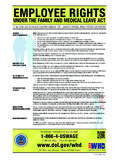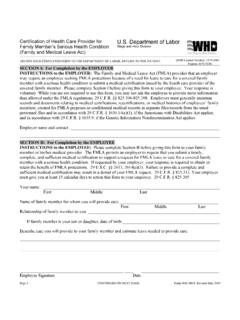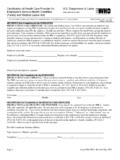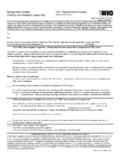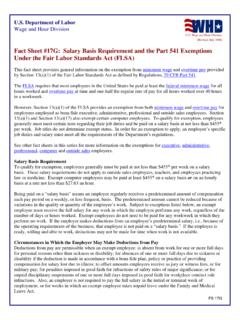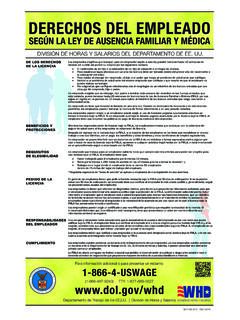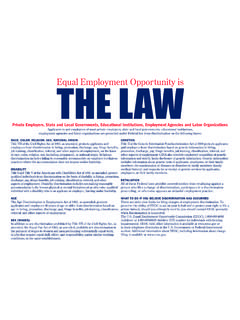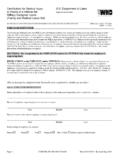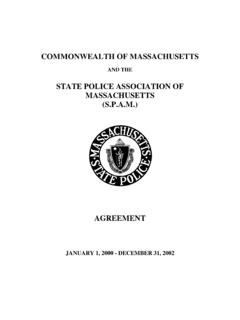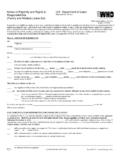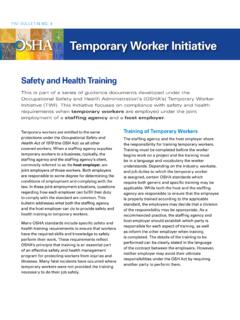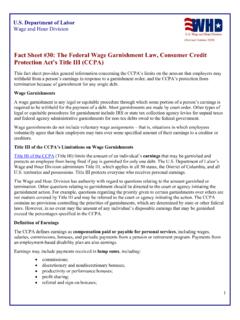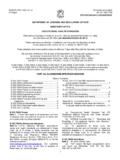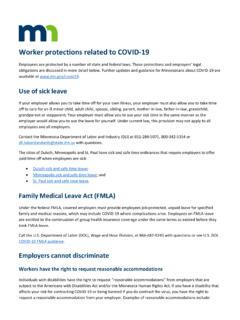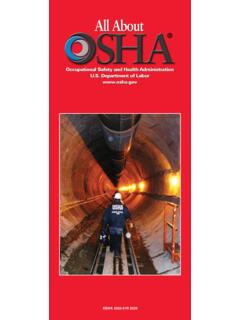Transcription of Worker Adjustment and Retraining Notification Act ...
1 The contents of this document do not have the force and effect of law and are not meant to bind the public in any way, except as authorized by law or incorporated into a contract, cooperative agreement, or grant. This document is intended only to provide clarity to the public regarding existing requirements under the law or agency policies. DOL may not cite, use, or rely on any guidance that is not posted on this site, except to establish historical facts. Worker Adjustment and Retraining Notification Act Frequently Asked Questions Introduction The federal Worker Adjustment and Retraining Notification (WARN) Act (or Act) is enforced by private legal action brought in the District Court for any district in which the violation is alleged to have occurred or in which the employer transacts business.
2 Any dispute regarding the interpretation of the WARN Act including a closing or layoff s foreseeability will be determined on a case-by-case basis in the particular court proceeding. The role of the Department of Labor (Department) is limited to providing guidance and information about the WARN Act; such guidance is not binding on courts and does not replace the advice of an attorney. Some States have their own laws addressing layoffs and worksite closures. Information on State notice requirements can be obtained by contacting the applicable state dislocated Worker unit.
3 Employer Questions for COVID-19 I am an employer who temporarily laid off my employees at the beginning of the pandemic when we anticipated reopening the business after a few weeks. However, due to changing circumstances, I now am concerned that the layoff will need to be extended beyond 6 months, and may become permanent. When do I need to provide my employees with a WARN Notice? Short-term layoffs (6 months or less) that are later extended to last longer than originally contemplated are expressly addressed by the federal WARN Act and regulations. When a layoff is extended beyond 6 months, the layoff is treated as an employment loss from the date the layoff started and may violate the WARN Act unless: (1) the extension beyond 6 months is caused by business circumstances not reasonably foreseeable at the time of the initial layoff, and (2) notice is given at the time it becomes reasonably foreseeable that the extension beyond 6 months will be required.
4 Depending on the specific circumstances, events that lead an individual employer to unexpectedly decide to extend the duration of a furlough or layoff may constitute unforeseeable business circumstances such that a shortened notice period may be consistent with the requirements of the WARN Act. An employer s extension of the layoff will be judged based on whether the need to extend the layoff could reasonably have been foreseen as of the time notice would have been required. The length of notice will be judged based on whether notice was provided at the point when it became reasonably foreseeable that extension of the layoff would be required.
5 An employer relying on this exception from the general rule for notice is responsible for showing that the conditions for the exception were met. Please see WARN Act, 29 2102(c), and the regulations at 20 CFR (b). Am I covered by the WARN Act? The WARN Act requires employers with 100 or more full-time employees (not counting workers who have fewer than 6 months on the job) to provide at least 60 calendar days advance written notice of a worksite closing affecting 50 or more employees, or a mass layoff affecting at least 50 employees and 1/3 of the worksite s total workforce or 500 or more employees at the single site of employment during any 90-day period.
6 Not all dislocations require a 60-day notice; the WARN Act makes certain exceptions to the requirements when employers can show that layoffs or worksite closings occur due to faltering companies, unforeseen business circumstances, and natural disasters. In such instances, the WARN Act requires employers to provide as much notice to their employees as possible. If I am considering a temporary layoff or furlough, do I need to provide workers with a notice under the WARN Act? A WARN Act notice must be given when there is an employment loss, as defined under the Act.
7 A temporary layoff or furlough that lasts longer than 6 months is considered an employment loss. A temporary layoff or furlough without notice that is initially expected to last six months or less but later is extended beyond 6 months may violate the Act unless: 1. The extension is due to business circumstances (including unforeseeable changes in price or cost) not reasonably foreseeable at the time of the initial layoff; and 2. Notice is given when it becomes reasonably foreseeable that the extension is required. This means that an employer who previously announced and carried out a short-term layoff (6 months or less) and later extends the layoff or furlough beyond 6 months due to business circumstances not reasonably foreseeable at the time of the initial layoff is required to give notice at the time it becomes reasonably foreseeable that the extension is required.
8 A layoff extending beyond 6 months for any other reason is treated as an employment loss from the date the layoff or furlough starts. The WARN Act is enforced by private legal action in the District Court for any district in which the violation is alleged to have occurred or in which the employer transacts business. Thus an employer may need to prove that it could not foresee the circumstances if a WARN Act action is brought. Any dispute regarding the interpretation of the WARN Act including its foreseeability will be determined on a case-by-case basis in such a court proceeding.
9 The role of the Department of Labor is limited to providing guidance and information about the WARN Act; such guidance is not binding on courts and does not replace the advice of an attorney. For permanent layoffs, may I claim an exception to the WARN Act because of COVID-19? If I do, what are my responsibilities? The Department recommends that employers review the unforeseeable business circumstances exception to the 60-day notice requirement (contained in the WARN Act at 3(b)(2)(A), and the WARN regulations at 20 CFR ) set out below: The unforeseeable business circumstances applies to plant closings and mass layoffs caused by business circumstances that were not reasonably foreseeable at the time that 60-day notice would have been required.
10 (1) An important indicator of a business circumstance that is not reasonably foreseeable is that the circumstance is caused by some sudden, dramatic, and unexpected action or condition outside the employer s control. A principal client s sudden and unexpected termination of a major contract with the and an unanticipated and dramatic major economic downturn might each be considered a business circumstance that is not reasonably foreseeable. A government ordered closing of an employment site that occurs without prior notice also may be an unforeseeable business circumstance.
